Reverse Polish notation (RPN), also known as reverse Łukasiewicz notation, Polish postfix notation or simply postfix notation, is a mathematical notation in which operators follow their operands, in contrast to prefix or Polish notation (PN), in which operators precede their operands. The notation does not need any parentheses for as long as each operator has a fixed number of operands.
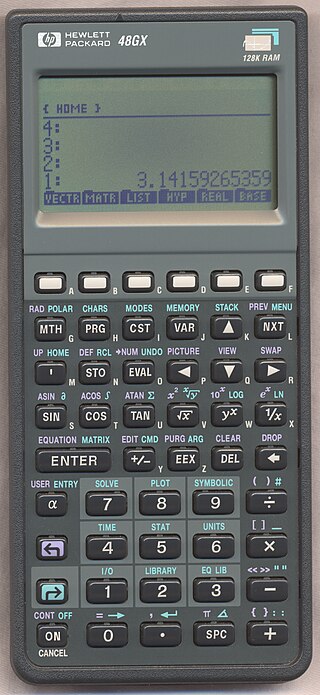
The HP 48 is a series of graphing calculators designed and produced by Hewlett-Packard from 1990 until 2003. The series includes the HP 48S, HP 48SX, HP 48G, HP 48GX, and HP 48G+, the G models being expanded and improved versions of the S models. The models with an X suffix are expandable via special RAM and ROM cards. In particular, the GX models have more onboard memory than the G models. The G+ models have more onboard memory only. The SX and S models have the same amount of onboard memory.
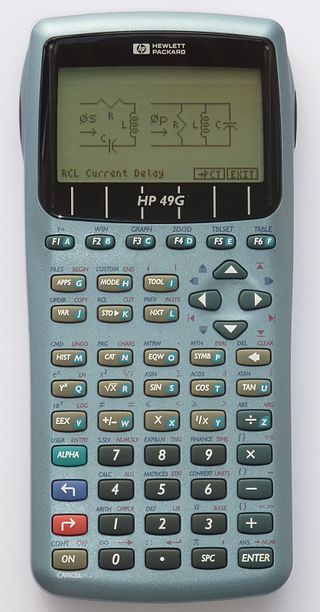
The HP 49/50 series are Hewlett-Packard (HP) manufactured graphing calculators. They are the successors of the popular HP 48 series.
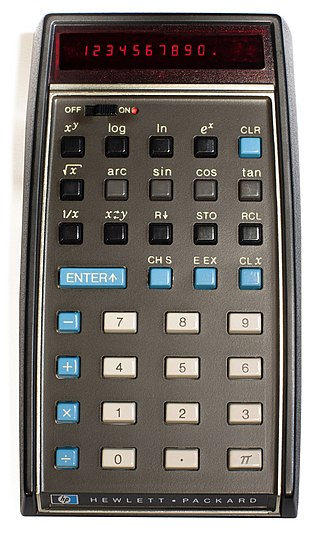
The HP-35 was Hewlett-Packard's first pocket calculator and the world's first scientific pocket calculator: a calculator with trigonometric and exponential functions. It was introduced in 1972.
RPL is a handheld calculator operating system and application programming language used on Hewlett-Packard's scientific graphing RPN calculators of the HP 28, 48, 49 and 50 series, but it is also usable on non-RPN calculators, such as the 38, 39 and 40 series. Internally, it was also utilized by the 17B, 18C, 19B and 27S.

The HP 33s (F2216A) was a scientific calculator marketed by Hewlett-Packard. It was introduced in 2003 as the successor to the HP 32SII, and discontinued on the introduction of its successor the HP 35s in 2007.
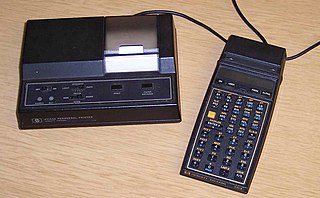
The HP-41C series are programmable, expandable, continuous memory handheld RPN calculators made by Hewlett-Packard from 1979 to 1990. The original model, HP-41C, was the first of its kind to offer alphanumeric display capabilities. Later came the HP-41CV and HP-41CX, offering more memory and functionality.

The HP-42S RPN Scientific is a programmable RPN Scientific hand held calculator introduced by Hewlett-Packard in 1988. It has advanced functions suitable for applications in mathematics, linear algebra, statistical analysis, computer science and others.

The HP 38G is a programmable graphing calculator by Hewlett-Packard (HP). It was introduced in 1995 with a suggested retail price of US$80. HP credits a committee of eight high school, community college, and university teachers with assisting in the design of the calculator.
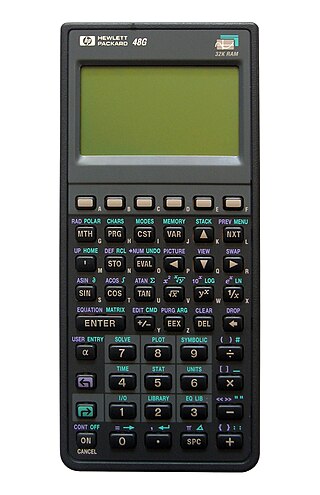
HP calculators are various calculators manufactured by the Hewlett-Packard company over the years.
Programmable calculators are calculators that can automatically carry out a sequence of operations under control of a stored program. Most are Turing complete, and, as such, are theoretically general-purpose computers. However, their user interfaces and programming environments are specifically tailored to make performing small-scale numerical computations convenient, rather than general-purpose use.

The HP-71B was a hand-held computer or calculator programmable in BASIC, made by Hewlett-Packard from 1984 to 1989.

The HP-28C and HP-28S were two graphing calculators produced by Hewlett-Packard from 1986 to 1992. The HP-28C was the first handheld calculator capable of solving equations symbolically. They were replaced by the HP 48 series of calculators, which grew from the menu-driven RPL programming language interface first introduced in these HP-28 series.

The HP 35s (F2215A) is a Hewlett-Packard non-graphing programmable scientific calculator. Although it is a successor to the HP 33s, it was introduced to commemorate the 35th anniversary of the HP-35, Hewlett-Packard's first pocket calculator. HP also released a limited production anniversary edition with shiny black overlay and engraving "Celebrating 35 years".
In computing HP Roman is a family of character sets consisting of HP Roman Extension, HP Roman-8, HP Roman-9 and several variants. Originally introduced by Hewlett-Packard around 1978, revisions and adaptations were published several times up to 1999. The 1985 revisions were later standardized as IBM codepages 1050 and 1051. Supporting many European languages, the character sets were used by various HP workstations, terminals, calculators as well as many printers, also from third-parties.
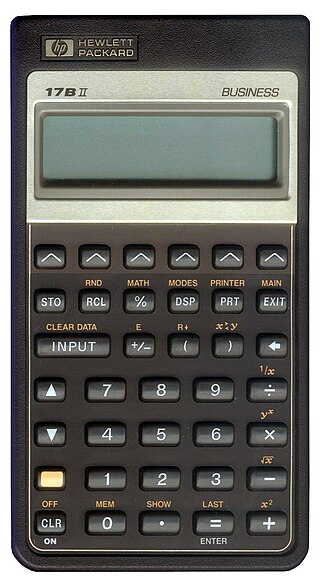
HP-17B is an algebraic entry financial and business calculator manufactured by Hewlett-Packard, introduced on 4 January 1988 along with the HP-19B, HP-27S and the HP-28S. It was a simplified business model, like the 19B. There were two versions, the US one working in English only, and the international one with a choice of six languages.

HP-19B, introduced on 4 January 1988, along with the HP-17B, HP-27S and the HP-28S, and replaced by the HP-19BII (F1639A) in January 1990, was a simplified Hewlett Packard business model calculator, like the 17B. It had a clamshell design, like the HP-18C, HP-28C and 28S.

The HP Prime Graphing Calculator is a graphing calculator introduced by Hewlett-Packard in 2013 and manufactured by HP Inc. until the licensees Moravia Consulting spol. s r.o. and Royal Consumer Information Products, Inc. took over the continued development, manufacturing, distribution, marketing and support in 2022. It was designed with features resembling those of smartphones, such as a full-color touchscreen display and a user interface centered around different applications. It claims to be the world's smallest and thinnest CAS-enabled calculator currently available.
The RPL character set is an 8-bit character set and encoding used by most RPL calculators manufactured by Hewlett-Packard as well as by the HP 82240B thermo printer. It is sometimes referred to simply as "ECMA-94" in documentation, although it is for the most part a superset of ISO/IEC 8859-1 / ECMA-94 in terms of printable characters, and it differs from ISO/IEC 8859-1 by using displayable characters rather than control characters in the 0x80 to 0x9F range of code points.
In computing FOCAL character set refers to a group of 8-bit single byte character sets introduced by Hewlett-Packard since 1979. It was used in several RPN calculators supporting the FOCAL programming language, like the HP-41C/CV/CX as well as the later HP-42S, which was introduced in 1988 and produced up to 1995. As such, it is also used by SwissMicros' DM41/L, both introduced in 2015, and is implicitly supported by the DM42, introduced in 2017.














